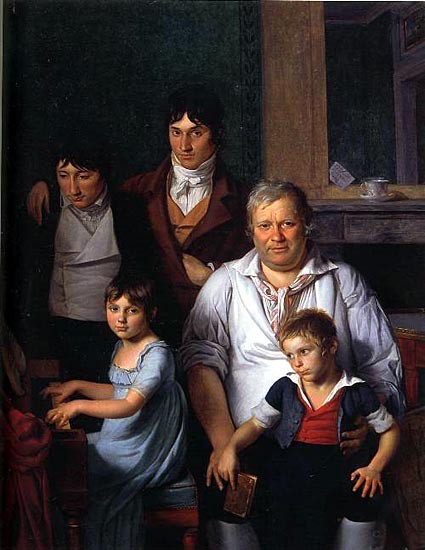This extraordinary family portrait is one of the great enigmas of early 19th-century art history since the identity of the subjects and painter has remained a mystery to this day. The work was initially attributed to David – perhaps because of its undoubtedly exceptional quality of the work – and the father of the family was identified as the member of the Convention, Michel Gérard, however today those attributions have been abandoned, and art historians have concentrated on trying to find meaning in the image.
It is the figure of the father which first of all attracts attention with his solid bodily appearance and state of undress. Yet he has a warm and comforting air about him, and he provides the central element around which the family circles thus forming, as a result, the centre of the composition of the painting. The frontality of the pose, the realistic treatment of the face and the imposing white shirt contrast strongly with the free movements of the two young children. The painting in itself marks a moment in the evolution of the family portrait, a genre which grew in popularity throughout the 18th century. Moving from the traditional Ancien Régime representation of the all powerful father, the very symbol of authority and pride of one family name, here we see the beginnings of a more intimate vision, giving to the pater familias emotions, even sensitivity and a tenderness which had never appeared before. As a direct result of the Enlightenment, much more attention was paid to the education of children: here the boy is reading and the girl plays the piano, and the father apparently keeps a close eye on their progress.
The composition of the family group is completed by the representation, in the background, of the two brothers. The pyramidal construction of the ensemble culminates in the oldest child, thus confirming his status as heir. He too appears as the assured protector of the group. We are perhaps invited to see here the affirmation of the opportunities offered to middle class families in post-Revolutionary society for those with education and personal merit. But beyond the sociological interpretation of the group, it is the absence of the mother which remains the great mystery in this painting. The physical proximity of the figures around the central figure of the father leaves an obvious hole next to the fireplace where there stand a letter and a tea cup, two indications of a feminine presence. Was the wife and mother dead, or was she the painter and in fact behind the easel at that moment painting her loved ones? Who knows?
Karine Huguenaud (tr. P.H.)
December 2006
Portrait of a man and his children
Artist(s) : Anonymous

- Date :
- circa 1810
- Technique :
- oil on canvas
- Dimensions :
- H = 1.57 m, L = 1.25 m
- Place held :
- Le Mans, Musée du Tessé
- Photo credit :
- © musée du Tessé

